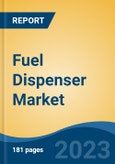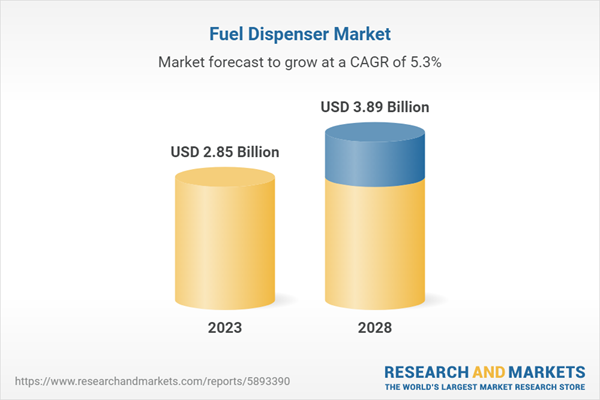Free Webex Call
The Fuel dispenser market is expected to grow during the forecast period due to the widespread acceptance of advanced fuel dispensers across fuel centers and gas stations worldwide and the increasing trend of mass production in major end-use industries to minimize the overall production cost, is anticipated to drive the demand for fuels, which, in turn, is anticipated to boost the growth of the global fuel dispenser market during the estimate period. In addition, development in awareness and implementation of biofuels from buyers across the globe is estimated to fuel the demand for biofuel dispensers, which is expected to drive the growth of the market in the coming years. Though, an increase in demand for electric vehicles and a decrease in the number of petroleum fuel-based stations are expected to hinder the growth of the global fuel dispenser market during the forecast period. Speak directly to the analyst to clarify any post sales queries you may have.
10% Free customizationThis report comes with 10% free customization, enabling you to add data that meets your specific business needs.
A fuel dispenser is a prominent device in fuel stations, which is employed to dispense or examine liquid or gaseous fuel. It is operated to pump liquid or gaseous fuels such as petrol, diesel, and natural gas into vehicles, aircraft, storage tanks, or portable containers. The fuel dispenser system includes several parts including hydraulic, metering, and hose/nozzle portions. The design and formation of these systems depend on numerous factors, such as the number of grades, volume of business, fuel products, and facility size. Dispensers concurrently deliver fuel and analyze the price of fuel delivered into the vehicle.
Global Fuel Dispenser Market: Drivers & Trends
Rise In Demand for Petroleum and CNG Products in Developing Economies
The increase in demand for petroleum fuels and Compressed Natural Gas (CNG) products from emerging economies such as China, India, Australia, and others is estimated to be the leading factor in the growth of the global fuel dispenser market. In addition, there is brisk acceptance of natural gas automobiles and an increase in the consumption of petroleum fuels in these emerging economies. This is estimated to propel the demand for fuel stations which in turn is anticipated to propel the growth of the global fuel dispenser market during the analyzed time frame. Moreover, the global automotive industry has conveyed substantial growth from 2010 to 2019 as the demand for passenger vehicles to commercial vehicles was at its peak.Currently, the automotive market is advancing at a high rate in promising economies, such as India, China, and others. In addition, the developed regions, such as North America and Europe, cover the foremost share in both automotive production and sales. China is the major country-level market that reports the highest production and sales statistics due to technological advancements, superior manufacturing facilities, and a drastic rise in the population, which results in high vehicle demand.
This rapid growth in the production and sales of motor vehicles is anticipated to drive the demand for petroleum and other fuels, which in turn, is estimated to drive the growth of the fuel dispenser market during the forecast period.
Rapid Growth of Dual Fuel or Hybrid Automobiles
Rapid development in the creation and retailing of hybrid automobiles is expected to drive the growth of the global fuel dispenser market during the estimated period. Additionally, hybrid automobiles show numerous advantages such as competence to achieve zero emissions, monetary profits, flexibility to run on auxiliary fuels, and power generation from regenerative decelerating as compared to conventional automobiles, which encourage the growth of the global fuel dispenser market. In addition, hybrid vehicles are more efficient in terms of traveling time and safety as compared to conventional vehicles, owing to their ability to generate regenerative power by applying brakes. Furthermore, dual fuel vehicles possess advantages such as less price, lower emissions, less maintenance, and easier operation, which are projected to fuel their demand in the upcoming years, which is further expected to propel the growth of the global market from 2024 to 2028. Moreover, the introduction of hydrogen gas-powered vehicles, which do not release carbon emissions, exhaust lesser energy as evaluated to diesel fuel, and generate low noise & vibration is expected to fuel the market growth during the analyzed timeframe.Global Fuel Dispenser Market: Restraints
Rise in Awareness and Stringent Government Regulations Toward Vehicle Emissions
Diesel and other established fuel-powered automobiles emit harmful pollutants and gases such as carbon dioxide, nitrogen oxide, particulate matter, and sulphur dioxide. These air contaminants severely impact human health, affecting diseases such as stroke, cardiac disorders, lung cancer, and asthma. Additionally, these air pollutants are dangerous to surroundings, as nitrogen dioxide is farther harmful to the ozone layer than carbon dioxide. To decrease the harmful effects of these harmful emissions on humans and the environment, various policies, regulations, and initiatives are employed by governments across the world. For instance:
- Central Pollution Control Board & Ministry of Environment and Forests Emission standards for new gensets with up to 800 kW- GSR (Generator Set Regulations) 771E, GSR 535E, 232E, and 489E (India)
- EPA emission standard for Emergency Standby Diesel Generator
- Paris Agreement 2015 COP 21 for greenhouse gas reduction - Targets 2021-2030
- United Nations Framework Convention on Climate Change 1992
- The U.S. multi-state zero emission vehicle action plan
- UNECE regulation 83 and type 1 test NEDC
- European CO2 Regulation 2025/2030
- Kyoto Protocol 1998 COP 3
- EU Stationary Engines:
- Industrial Emissions Directive (P ≥ 50 MW)
- Medium Combustion Plant Directive (1 ≤ P < 50 MW)
Increase in Demand for Electric Vehicles and Reducing Number of Fuel Stations
The rise in demand for electric vehicles and government initiatives & investment in the electric vehicle industry is expected to hamper the growth of the conventional fuel dispenser market during the forecast period. Thus, owing to the initiatives to promote the use of electric vehicles, the production of electric vehicles is expected to increase at an exponential rate, which, in turn, will restrain the demand for petroleum-based or other conventional fuel dispensers in the years to come. Moreover, the surge in pollution and decline in fossil fuel reserves have improved the government's attention toward the use of electric vehicles.Furthermore, the increase in carbon emissions have increased global warming at an alarming rate that has imposed countries globally to reduce their carbon emissions. Numerous countries among the world are providing inducements to support the use of zero emission cars either electric or hybrid. Numerous national governments around the world provide economic incentives such as tax exemptions and tax credits. For instance, electric vehicles in Austria are exempted from fuel consumption/pollution tax, ownership tax, and company car tax. In addition, a deduction of the value-added tax (VAT) is applicable for electric vehicles. These above-mentioned factors are expected to hamper the growth of the conventional fuel dispenser market during the forecast period.
Furthermore, the number of fuelling stations are on the verge of decline, owing to rise in sales of electric vehicle, new mobile fuel delivery stations, and others, which in turn is expected to restrain the growth of the petroleum fuel-based dispenser market in the upcoming years.
Global Fuel Dispenser Market: Opportunities
Technological Advancements and R&D Toward Highly Efficient Fuel Dispenser Systems:
Technological advancements such as inclusion of digital innovations, automation, and others are playing key role in the growth of the fuel dispenser market globally. In addition, the introduction of electronic embedded dispensing system, cloud platforms, and other digital systems in the fuel dispensers is expected to create opportunity for key players in the market. Rise in demand from consumers toward seamless retail fuelling experience, faster & efficient fuelling and others has increased attention of key players which is further resulted in increasing research and development activities toward providing highly efficient fuel dispenser systems. This is anticipated to create key opportunity for key players in the fuel dispenser market in the upcoming years.Market Segments
Global fuel dispenser market is segmented into fuel type, dispenser system, flow meter, application and region. Based on fuel type, the market is segmented into petroleum fuels, compressed fuels, biofuels, and others. Based on dispenser system, the market is segmented into submersible and suction. Based on flow meter, the market is segmented mechanical & electronics. Based on application, the market is segmented into Petrol, diesel, biofuel, and others. Based on region, the market is segmented into Europe, North America, Asia-Pacific, South America, Middle East & Africa.Market Players
- Major market players in the global fuel dispenser market are Dover Fueling Solutions, Gilbarco Inc, Tatsuno Corporation, Scheidt & Bachmann Tubs d.o.o., Bennett Pump Company, NEOTEC, Piusi SpA, Lanfeng Technology Inc., Tominaga Mfg Co., Censtar Science & Technology Corp., Ltd.
Report Scope:
In this report, global Fuel Dispenser market has been segmented into following categories, in addition to the industry trends which have also been detailed below:Fuel Dispenser Market, By Fuel Type:
- Petroleum Fuels
- Compressed Fuels
- Biofuels
- Others
Fuel Dispenser Market, By Dispenser System:
- Submersible
- Suction
Fuel Dispenser Market, By Flow Meter:
- Mechanical
- Electronics
Fuel Dispenser Market, By Application:
- Petrol
- Diesel
- Biofuel
- Others
Fuel Dispenser Market, By Region:
- North America
- United States
- Canada
- Mexico
- Asia pacific
- China
- India
- Japan
- South Korea
- Australia
- Europe
- Germany
- Italy
- Spain
- United Kingdom
- France
- South America
- Brazil
- Argentina
- Colombia
- Middle East & Africa
- South Africa
- Saudi Arabia
- UAE
Competitive Landscape
Company Profiles: Detailed analysis of the major companies present in Global Fuel Dispenser Market.Available Customizations:
Global Fuel Dispenser Market with the given market data, the publisher offers customizations according to a company’s specific needs.This product will be delivered within 1-3 business days.
Table of Contents
1. Product Overview
2. Research Methodology
5. Global Fuel Dispenser Market Outlook
6. North America Fuel Dispenser Market Outlook
7. Asia-Pacific Fuel Dispenser Market Outlook
8. Europe Fuel Dispenser Market Outlook
9. South America Fuel Dispenser Market Outlook
10. Middle East & Africa Fuel Dispenser Market Outlook
11. Market Dynamics
13. Company Profiles (10 Major Companies)
15. About the Publisher & Disclaimer
Companies Mentioned
- Dover Fueling Solutions
- Gilbarco Inc
- Tatsuno Corporation
- Scheidt & Bachmann Tubs d.o.o.
- Bennett Pump Company
- NEOTEC
- Piusi SpA
- Lanfeng Technology Inc.
- Tominaga Mfg Co.
- Censtar Science & Technology Corp., Ltd.
Table Information
| Report Attribute | Details |
|---|---|
| No. of Pages | 181 |
| Published | October 2023 |
| Forecast Period | 2023 - 2028 |
| Estimated Market Value ( USD | $ 2.85 Billion |
| Forecasted Market Value ( USD | $ 3.89 Billion |
| Compound Annual Growth Rate | 5.3% |
| Regions Covered | Global |
| No. of Companies Mentioned | 10 |









